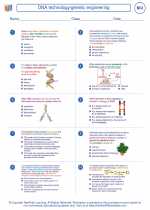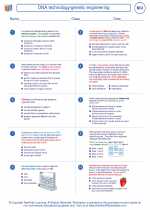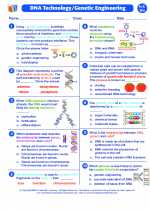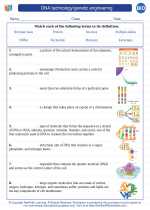Double Replacement Reactions
Double replacement reactions, also known as double displacement reactions, occur when parts of two ionic compounds switch places, resulting in the formation of two new compounds. These reactions typically take place in aqueous solutions and are characterized by the formation of a precipitate, gas, or water.
General Equation
The general form of a double replacement reaction can be represented as:
AB + CD → AD + CB
Where A, B, C, and D represent cations or anions in the ionic compounds.
Key Characteristics
- Formation of a precipitate: In some double replacement reactions, an insoluble solid compound, called a precipitate, is formed.
- Formation of a gas: Certain double replacement reactions result in the formation of a gaseous product, which may be observed as bubbles.
- Formation of water: In some cases, the reaction may produce water as one of the products.
Example
An example of a double replacement reaction is the reaction between silver nitrate (AgNO3) and sodium chloride (NaCl) to form silver chloride (AgCl) and sodium nitrate (NaNO3):
AgNO3 + NaCl → AgCl + NaNO3
Study Guide
To understand and master double replacement reactions, consider the following study guide:
- Learn and understand the solubility rules for common ionic compounds. This knowledge will help predict whether a double replacement reaction will produce a precipitate.
- Practice balancing chemical equations, as double replacement reactions involve the rearrangement of ions to form new compounds.
- Experiment with different combinations of reactants to observe the formation of precipitates, gases, or water, and verify the products of the reactions.
- Study examples of double replacement reactions in various contexts, such as in biological systems, environmental processes, and industrial applications.
- Review the concept of net ionic equations to focus on the essential ions involved in the reaction and understand the changes occurring at the molecular level.
By understanding the principles and applications of double replacement reactions, you can gain insights into various chemical processes and their significance in biological, environmental, and industrial contexts.
[Double Replacement Reactions] Related Worksheets and Study Guides:
.◂Biology Worksheets and Study Guides High School. DNA technology/genetic engineering

 Worksheet/Answer key
Worksheet/Answer key
 Worksheet/Answer key
Worksheet/Answer key
 Worksheet/Answer key
Worksheet/Answer key
 Vocabulary/Answer key
Vocabulary/Answer key
 Vocabulary/Answer key
Vocabulary/Answer key
 Vocabulary/Answer key
Vocabulary/Answer key
